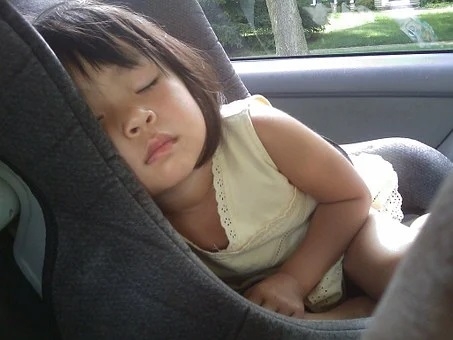Napping - What age should they stop?
January 1st, 2021
1043 Views

I must be honest, when my children had their daytime naps, I became jet-propelled and achieved a huge amount of domestic engineering – and even prepared a ‘ joined up’ dinner! Occasionally, I managed to sit down and read some of my magazine or book, but good things never last forever and soon the daily naps had gone forever!
Sleep is vital to babies as it helps their physical and mental development. It is amazing to think that during their first year, most babies drop from five/six daytime sleeps to two. Most children, until they are about 18 months old, continue to have two naps during the day – one mid-morning, the other early afternoon. This then drops down to one nap of about 1.5 hours – usually taken early afternoon and never beyond 4.00 p.m. or bedtime is torpedoed!
When this single nap is dropped altogether, varies from one child to another; some let it go at two years old, the average age is three and some four year olds still enjoy (and need) a siesta! The average two year old needs 12-14 hours sleep each day, whilst by three years old this has decreased to 11-13 hours.
The best thing to do is experiment a little and find out how your child copes without any daytime naps. They are not ready to bin their daytime siesta if any of the following occur...
Sleep is vital to babies as it helps their physical and mental development. It is amazing to think that during their first year, most babies drop from five/six daytime sleeps to two. Most children, until they are about 18 months old, continue to have two naps during the day – one mid-morning, the other early afternoon. This then drops down to one nap of about 1.5 hours – usually taken early afternoon and never beyond 4.00 p.m. or bedtime is torpedoed!
When this single nap is dropped altogether, varies from one child to another; some let it go at two years old, the average age is three and some four year olds still enjoy (and need) a siesta! The average two year old needs 12-14 hours sleep each day, whilst by three years old this has decreased to 11-13 hours.
The best thing to do is experiment a little and find out how your child copes without any daytime naps. They are not ready to bin their daytime siesta if any of the following occur...

They end up grumpy late afternoon and fall asleep early evening – well before their usual bedtime.
They are just irritable from late morning onwards.
They resist going for their usual nap, but then fall asleep really quickly.
As Sleep Consultant, Nicole Cannon explains -‘A very big issue I see with those that cut the nap too soon, is early rising that results from either a very early bedtime because they are so exhausted without their daily nap, or conversely a bedtime that is too late without the nap and the child becomes overtired causing an early morning wake up,"
The main point is that about three years old, most children should be able to manage without any daytime naps. There will definitely still be occasional naps, especially if you go out in the car - when the snoring will usually begin within ten minutes- and if you have a period of inactivity at home, you may well suddenly find your child stretched out on the sofa or lounge carpet enjoying a few zzzzz….
The bonus of dispelling with daytime naps is that your child will be ready to start the bedtime routine just after six in the evening and will be asleep by 7.00 p.m. - can you imagine having an evening to share, just you and your partner- amazing!
You may well find that once your child no longer has a daytime nap, that they sleep though the night and may well even wake a little later in the morning – oh joy! You will find yourself making their bedtime earlier, but this is no hardship. It is definitely the right moment to really define the bedtime routine as this will help prepare your child for a good night’s sleep.
Although some children do wean themselves off their daytime nap, it is best to
gently engineer the disappearance of their daytime siesta! Suddenly stopping the daytime nap and letting your child adjust ‘cold turkey’ is one guaranteed way to have a really grumpy, cranky child on your hands! The best way is to slowly and steadily reduce their daily nap time. This is best done by reducing it by ten minutes every second day – literally shave ten minutes off their usual nap time and plan something special for when they wake like a play in the sand pit or a walk in the park and they will not notice anything!
Indicators that it is time to stop your child's daytime naps:
Your child is taking a long time to fall asleep at nap time and remaining
fidgety.Having had a daytime nap, your child does not seem tired at bedtime or
they wake extremely early in the morning.Your child can successfully handle being awake for more hours during the day.

Even when your child has dispelled with their daily naps, they will need a period each day when they can do something restful, like colouring or sharing some books with you. This is necessary as it will ‘help recharge their batteries’. It can be helpful to prepare a special small box with books, puzzles and other ‘quiet’ toys that your child can only enjoy during these quiet spells as it will make them look forward to them. You may find, that in the early days, your child, does still fall asleep occasionally in the afternoon, which is fine, but it is best to limit the length of time so that they are tired at bedtime.
The main point is that there are no hard and fast rules where daytime naps are concerned as your child is totally different from all their friends. When you feel the time is right, try dispensing with their nap – you will soon know if you has misjudged the timing! Nothing is set in stone so you can revert to their daytime nap schedule and tray again in a few weeks time….
The main point is that there are no hard and fast rules where daytime naps are concerned as your child is totally different from all their friends. When you feel the time is right, try dispensing with their nap – you will soon know if you has misjudged the timing! Nothing is set in stone so you can revert to their daytime nap schedule and tray again in a few weeks time….
Chrissie x

